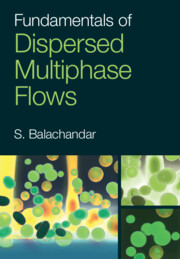Refine search
Actions for selected content:
5487 results in Thermal-fluids engineering
10 - Collisions, Coagulation, and Breakup
-
- Book:
- Fundamentals of Dispersed Multiphase Flows
- Published online:
- 22 March 2024
- Print publication:
- 28 March 2024, pp 352-384
-
- Chapter
- Export citation
Contents
-
- Book:
- Fundamentals of Dispersed Multiphase Flows
- Published online:
- 22 March 2024
- Print publication:
- 28 March 2024, pp v-viii
-
- Chapter
- Export citation
14 - Particle-Resolved Simulations
-
- Book:
- Fundamentals of Dispersed Multiphase Flows
- Published online:
- 22 March 2024
- Print publication:
- 28 March 2024, pp 469-486
-
- Chapter
- Export citation
Appendix F - Derivation of the MRG Equation with Reciprocal Theorem
-
- Book:
- Fundamentals of Dispersed Multiphase Flows
- Published online:
- 22 March 2024
- Print publication:
- 28 March 2024, pp 619-622
-
- Chapter
- Export citation
Reviews
-
- Book:
- Fundamentals of Dispersed Multiphase Flows
- Published online:
- 22 March 2024
- Print publication:
- 28 March 2024, pp ii-ii
-
- Chapter
- Export citation
13 - Multiphase Flow Approaches
-
- Book:
- Fundamentals of Dispersed Multiphase Flows
- Published online:
- 22 March 2024
- Print publication:
- 28 March 2024, pp 450-468
-
- Chapter
- Export citation
Appendix A - Index Notation
-
- Book:
- Fundamentals of Dispersed Multiphase Flows
- Published online:
- 22 March 2024
- Print publication:
- 28 March 2024, pp 605-608
-
- Chapter
- Export citation
11 - Filtered Multiphase Flow Equations
-
- Book:
- Fundamentals of Dispersed Multiphase Flows
- Published online:
- 22 March 2024
- Print publication:
- 28 March 2024, pp 385-422
-
- Chapter
- Export citation
9 - Particle–Particle Interactions
-
- Book:
- Fundamentals of Dispersed Multiphase Flows
- Published online:
- 22 March 2024
- Print publication:
- 28 March 2024, pp 296-351
-
- Chapter
- Export citation
Appendices
-
- Book:
- Fundamentals of Dispersed Multiphase Flows
- Published online:
- 22 March 2024
- Print publication:
- 28 March 2024, pp 605-622
-
- Chapter
- Export citation
Appendix B - Vector Calculus
-
- Book:
- Fundamentals of Dispersed Multiphase Flows
- Published online:
- 22 March 2024
- Print publication:
- 28 March 2024, pp 609-611
-
- Chapter
- Export citation
7 - Particle–Turbulence Interaction in the Dilute Limit
-
- Book:
- Fundamentals of Dispersed Multiphase Flows
- Published online:
- 22 March 2024
- Print publication:
- 28 March 2024, pp 181-241
-
- Chapter
- Export citation
Appendix C - Added Dissipation of an Isolated Particle
-
- Book:
- Fundamentals of Dispersed Multiphase Flows
- Published online:
- 22 March 2024
- Print publication:
- 28 March 2024, pp 612-613
-
- Chapter
- Export citation
15 - Euler–Lagrange Approach
-
- Book:
- Fundamentals of Dispersed Multiphase Flows
- Published online:
- 22 March 2024
- Print publication:
- 28 March 2024, pp 487-547
-
- Chapter
- Export citation
1 - Introduction
-
- Book:
- Fundamentals of Dispersed Multiphase Flows
- Published online:
- 22 March 2024
- Print publication:
- 28 March 2024, pp 1-17
-
- Chapter
- Export citation

Fundamentals of Dispersed Multiphase Flows
-
- Published online:
- 22 March 2024
- Print publication:
- 28 March 2024
-
- Textbook
- Export citation
Acknowledgments
-
- Book:
- Field Theory of Multiscale Plasticity
- Published online:
- 14 December 2023
- Print publication:
- 04 January 2024, pp xviii-xx
-
- Chapter
- Export citation
Author Index
-
- Book:
- Field Theory of Multiscale Plasticity
- Published online:
- 14 December 2023
- Print publication:
- 04 January 2024, pp 833-834
-
- Chapter
- Export citation
12 - Scale C
- from Part III - Applications I
-
- Book:
- Field Theory of Multiscale Plasticity
- Published online:
- 14 December 2023
- Print publication:
- 04 January 2024, pp 604-678
-
- Chapter
- Export citation
Preface
-
- Book:
- Field Theory of Multiscale Plasticity
- Published online:
- 14 December 2023
- Print publication:
- 04 January 2024, pp xv-xvii
-
- Chapter
- Export citation
